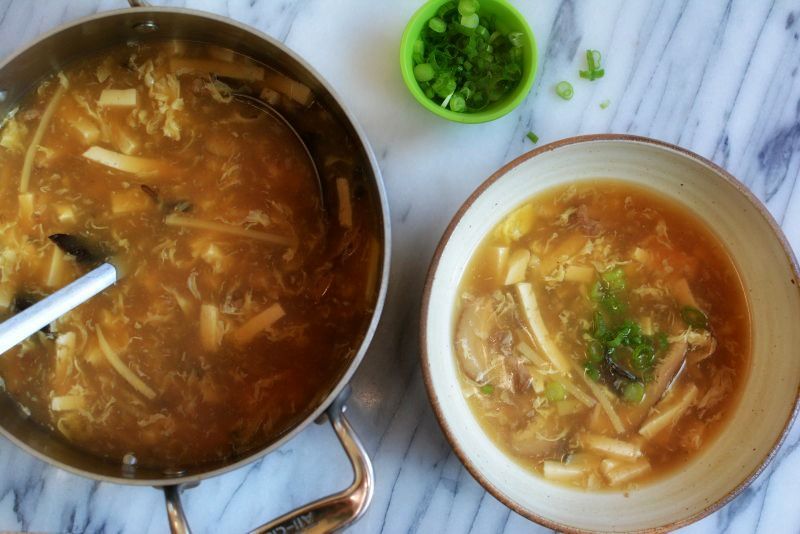
Simple and satisfying soups are commonly served with other dishes to make a multi-dish Asian meal but you don’t always have to follow convention! When autumn’s chill recently set in big time, I decided to make a pot of hot-and-sour soup for lunch. It was a main dish bowl of soup, the star of the meal instead of a supporting cast member.
It was wonderful because I got to focus on making then eat up a lot of one of my favorite Chinese soups. If you’re like me, you’ve likely had hot-and-sour soup at Chinese restaurants. In my case, I’ve rarely been satisfied by them. They tend to be thin and lacking depth. Sometimes they’re not even very hot (not enough white pepper) and/or sour (too little bracing vinegar).
I’ve been making my own suan la tang (酸辣汤) since I was a teenager, looking up recipes in Chinese cookbooks like Irene Kuo's and Barbara Tropp's and eventually created my own recipe for the Asian Tofu cookbook. Hot-and-sour soup is often associated with Beijing and Sichuan cooking. The regions are far apart but the hearty soup matches the bold fare that’s found in those areas.
Regardless of exact origin, it’s a hearty soup that embodies the Asian knack for balancing flavors and textures. Bits of mushroom, meat, tofu are suspended in silk broth. Cloudlike egg creates a dreamy effect, until you eat the soup. POW -- the hot-and-sour punch hits you yet every spoonful invites another until the bowl is empty.
Since we’ve been discussing glutamates and MSG, there’s a lot of glutamate-rich, umami goodness built into the hot-and-sour soup. Consider the major players: pork or beef, dried shiitake mushroom, tofu, stock (or broth) and soy sauce. The initial searing of the mushroom helps to develop a meaty quality to the soup. Bamboo shoot (or dried golden lily bulbs sold at Chinese markets) add a delicate funk to add to that foundation, too. If you're inclined, add several shakes of MSG or pinches of mushroom seasoning for an extra burst of flavor. I really depends on the ingredients that you used. For example, if your stock or broth was a little weak, then the flavor enhancer may help.
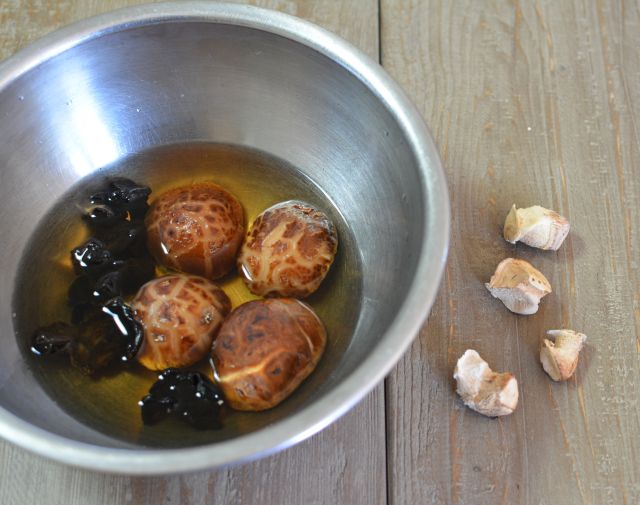
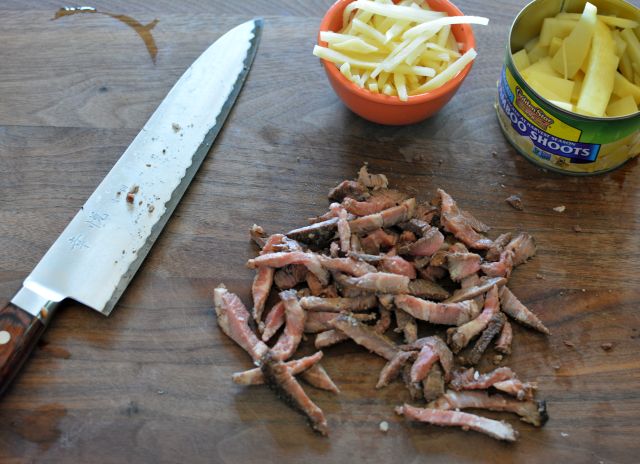
Pork is the usual meat encountered in hot-and-sour soup but we had some leftover coulotte steak in the fridge. Cut up into matchsticks and quickly marinated, the beef went super well with the hot-and-sour flavors. There are Muslims in northern China and beef is the go-to meat for Sichuan mapo tofu! That’s why this recipe calls for either beef or pork.
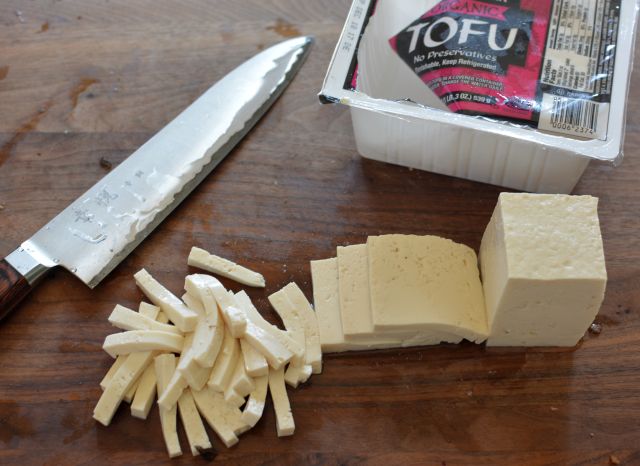
When you make the soup you'll wonder about the amount of cornstarch needed. I always do -- ¼ cup! There's a lot needed to create a silky texture. Add just enough to thicken things but also remember that the vinegar will break down a bit of the thickness.
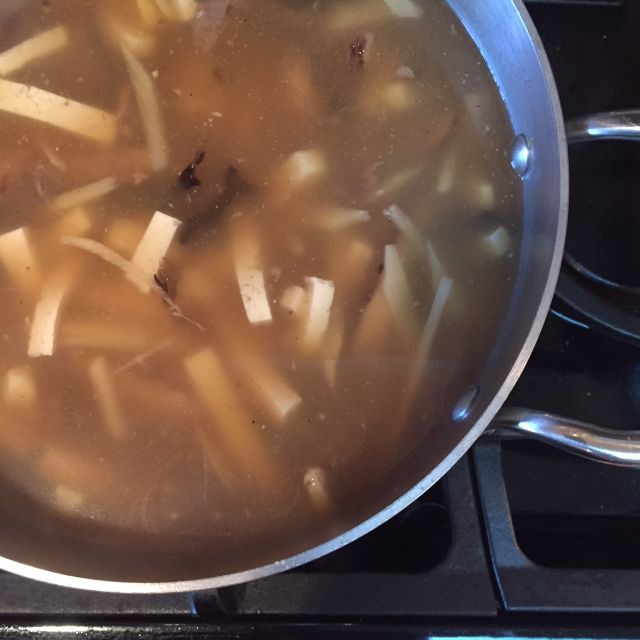
We ate our hot-and-sour soup for lunch two days in a row. You can enjoy it with bread or a side salad. The owner and chef of Shun Feng, a favorite Chinese restaurant in town, gifted me some mantou – northern Chinese steamed buns made of yeast-leavened bao dough shaped into balls and steamed. I’m always asking them about their staff meals so they occasionally give me little tastes.
If you want to make mantou, use the basic yeast dough on page 92 of my Asian Dumplings cookbook. Shape the dough into 12 to 16 balls, let them rise on parchment paper squares until nearly doubled, then steam them over boiling water in a Chinese steamer for about 10 to 12 minutes, until fluffy.
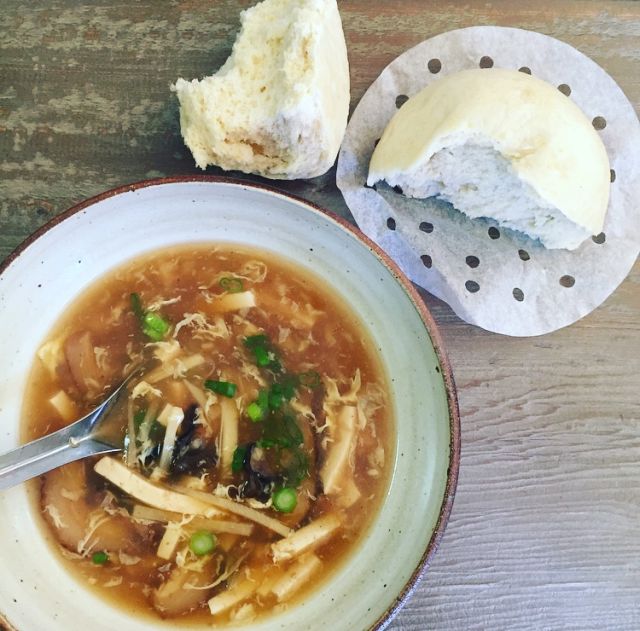
To make a vegetarian hot-and-sour soup: Increase the tofu to 12 ounces and use a vegetable stock (add a bit of the mushroom soaking liquid, if you like). You could instead keep the tofu at 8 ounces and cook 4 ounces of sliced cremini mushroom along with the shiitake at the front end. In any event, pour the marinade that would be used for the meat directly into the pot to punch things up.
Related posts:
- Dried Shiitake Mushroom Tips (buying, soaking and prepping)
- Shaoxing Rice Wine Primer (sourcing and using)
- Gluten-free Soy Sauce and Tamari Tasting
- How to Select Tofu for Your Recipes
Hot and Sour Soup (Suan La Tang)
Ingredients
- ¼ teaspoon fine sea salt, plus more as needed
- 1 teaspoon plus 1 ½ tablespoons regular or gluten-free soy sauce
- 1 teaspoon plus 1 tablespoon Shaoxing rice wine or dry sherry
- 2 teaspoons plus ¼ cup cornstarch
- 6 tablespoons plus 1 teaspoon water
- 4 to 5 ounces cooked beef steak or pork chop, or 5 to 6 ounces raw beef steak, boneless pork shoulder or loin, cut into scant ¼-inch-thick matchsticks
- 1 tablespoon neutral oil, such as canola
- Chubby 1-inch section fresh ginger, peeled, halved lengthwise, and bruised
- ½ cup matchstick-cut bamboo shoots, or 30 dried tiger lily bulbs, soaked and trimmed of knobby ends
- 4 large dried shiitake mushrooms, or 4 small dried shiitake mushrooms plus 4 or 5 cloud/wood ear mushrooms, soaked, trimmed, and sliced
- 6 cups homemade lightly salted chicken stock or canned chicken broth
- About ¾ teaspoon white pepper
- 8 ounces medium-firm or firm tofu, cut into ¼-inch-thick matchsticks (see tofu buying guide for tips)
- 1 large egg beaten with 1 teaspoon sesame oil
- About 2 tablespoons Chinkiang vinegar, or 1 tablespoon balsamic vinegar mixed with 1 tablespoon apple cider vinegar
- 1 green onion, white and green parts, thinly sliced, for garnish
Instructions
- In a bowl, combine the ¼ teaspoon salt, 1 teaspoon soy sauce, 1 teaspoon rice wine, 2 teaspoons cornstarch, and 1 teaspoon water. Add the beef or pork, stirring to coat well. Set aside.
- In a 3- or 4-quart pot, heat the oil over high heat. Add the ginger and cook, stirring frequently, for 1 minute, until the ginger is super fragrant. Add the bamboo shoot (or lily bulbs) and mushrooms, stir for about 15 seconds until you can smell their perfume, then add the stock.
- Bring to a boil, lower to a simmer, then add the remaining 1 ½ tablespoons soy sauce and 1 tablespoon rice wine. Taste and season with salt and white pepper. Aim for a spicy kick and savory depth. (If not serving right away, turn off the heat and cover.)
- Before serving, return the soup to a simmer and add the pork and tofu, stirring to separate. Meanwhile, combine the remaining ¼ cup cornstarch with the remaining 6 tablespoons water, stirring to dissolve.
- When the meat has just cooked through and the soup returns to a simmer, give the cornstarch a final stir, then gradually add to the soup. You may not need the entire amount. Aim to create a silky thick soup that’s not gloppy. The tofu should seem suspended in the soup but eventually fall to the bottom of the pot.
- When satisfied, give the egg a final stir, then pour it into the soup pot in a wide circle. Stir gently as the egg solidifies into suspended ribbons. Then add the vinegar, gently stirring. Taste and adjust the flavor with additional salt, white pepper, and/or vinegar. Ladle into a serving bowl or individual soup bowls. Scatter the green onion on top and serve immediately.













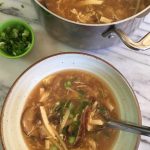




Yen says
Andrea,
I love this recipe and made it twice already with my own twist of course. I use fresh Shitake mushroom instead of dried. I also used tempeh instead of tofu. turned out great!
I've followed you on instagram for quite some time and decided to purchase both your Pho and Banh Mi book for Christmas gifts. Can't wait to dig into your recipes.
Please continue your great work and Happy Holidays.
Best,
Yen
Andrea Nguyen says
Hi Yen,
Thank you so much for taking time to cook, read and write! You just totally made my day. I love your idea of using tempeh because it's got an interesting texture and funk that goes well with the other flavors. It's earthiness pairs with shiitake, too! Smart cooking.
And, I greatly appreciate your getting my books. Banh mi and pho are among my favorite food groups!
Look forward to getting updates from you via Instagram ++.
Enjoy the holidays,
A.